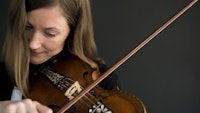Field of study: Performance Practice
Sunniva Thomassen: Extending the madrigal – the passaggi of the 16th Century.

How may the historically informed performer of today understand and perform the 'passaggi' as an imperative extension of the contrapuntal and poetic madrigal?
Summary
The subject of the dissertation is musical ornamentation – or diminution practice – in late 16th Century applied to the madrigals of Cipriano de Rore. The work emphasizes how the Italian passaggi from the field of performance practice should be seen as an extension of the composed madrigal itself. The principal aim is to explore the consequences of this claim for scholars and performers of renaissance music today, using counterpoint theory and literary theories of the 16th Century as prisms for my work.
In the first part of dissertation, Thomassen argues that ornamentation as performance practice and counterpoint theory are two sides of the same coin. She demonstrates this argument through a discussion of terminology of the historical term passaggi and its design and use in a contrapuntal context. The method is a hermeneutical and parallel reading of the treatises on music between 1550 and 1680 and ornamentation manuals in the late 16th Century. Moreover, she argues that understanding diminution as part of counterpoint theory will expand the possibilities for the performing musician to create diminutions as part of a harmonic, contrapuntal framework. This second argument is demonstrated by reflecting on counterpoint theory in the diminution manuals and diminution practice.
In the second part of the dissertation, Thomassen will explore diminution practice through the prism of literary theory of the 16th Century. The setting of text is a essential aspect of the madrigal of the 16th Century. Based on the understanding that diminution practice constitutes part of counterpoint theory and vice versa, she investigates whether or not the performer’s choice of diminutions may be influenced by the poetic text of the madrigals. The contrapuntal diminutions will be explored in the light of literary theories concerning affect and sound, scansion and rhythmical features of speech. I will argue that the choice of diminutions, although within a contrapuntal framework, is influenced by aspects beyond the rules of counterpoint, transgressing into an extension of the madrigal also as text set to music.
The material for study is Cipriano de Rore’s posthumous collection of madrigals for four voices from 1577 and the diminutions applied to them. In addition to the use as illustrations and examples, Thomassen argues that Rore’s music – and particularly the madrigals from this collection – has played an important role as a model for learning counterpoint for both theorists and practical musicians.
Diminution practice has been discussed thoroughly by many scholars and scholars-musicians, but not sufficiently in-depth situated between theory and practice. The connection between counterpoint theory and diminution practice is sometimes highlighted, but the practical consequences of this connection have not yet been sufficiently pursued. The poetry of the madrigals is often studied through analysis of unadorned madrigals in the field of counterpoint, while the link of the poems to diminution practice is often centred around the diminution as a single melodic line instead of as part of a contrapuntal framework. Moreover, the focal point of the latter has often been on semantic content above formal features such as sound and scansion. The overall contribution of the dissertation is hence to unify aspects of counterpoint theory, performance practice and literary theory in an overarching conception of the passaggi. As a result, Thomassen will broaden the understanding of ornamentation as performance practice in the Renaissance and today, exploring and blurring the distinction between composer and performer, framing the composed madrigal and the performed diminutions as its imperative extension.
Articles relevant
Published: Oct 18, 2016 — Last updated: Nov 1, 2024
